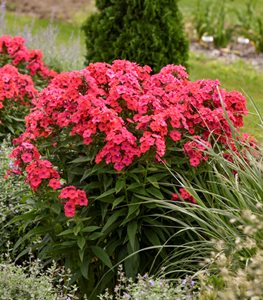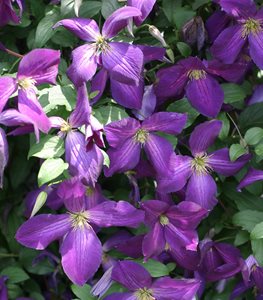ENGLISH GARDEN FLOWERS & PLANTS
Discover 14 plants typically found in English-style gardensThe climate in England is characterized by mild winters, cool summers, and regular rainfall year-round. Even if your region has different growing conditions, you can still achieve an English look by incorporating similar looking natives or other plants that do well in your area. Here are some plants that are commonly included in English gardens:
Read more: English Garden Ideas.
On this page: Flowers & Plants | English Garden Maintenance
On this page:
ENGLISH ROSES (Rosa spp.)
Zones: 4-11
Exposure: Full sun to partial shade
Growth habit: Upright, bushy or climbing habit
Height/Spread: 4 to 12 feet tall, 3 to 5 feet wide
Bloom time: Repeat or continuous bloom from late spring until fall
These hybrid shrubs or climbers combine the full-petaled flower form and intense fragrance of old roses with the wider color range, repeat bloom, and disease-resistance of modern roses. Also known as David Austin roses, they do best in milder regions with cooler summers. Makes an excellent cut flower. Read more about how to grow roses.
SHRUB ROSES (Rosa hybrid)
Buy Oso Easy® shrub roses from Proven Winners.
Zones: 3-11
Exposure: Full sun to partial shade
Growth habit: Mounding, bushy, spreading or groundcover habit
Height/Spread: 1 to 20 feet tall, 1 to 15 feet wide
Bloom time: Bloom time varies according to variety. These include one-time bloomers from late spring to early summer, as well as repeat and continuous bloomers that flower from late spring to frost.
Shrub roses are an easy-care alternative to more fussy hybrid teas. This diverse group includes hybrid musk, Kordesii, and English roses. The informal sprawling habit makes these a good choice for larger landscapes, mixed borders, mass plantings and slopes. Learn more about growing shrub roses.
CLIMBING ROSES (Rosa spp.)
Buy Rise Up™ series climbing roses from Proven Winners.
Zones: 2-10
Exposure: Full sun to partial shade
Growth habit: Climbing spreading habit
Height/Spread: 6 to 12 feet tall (or long), 3 to 4 feet wide
Bloom time: Late spring to frost
These are the romantic vining types that are seen growing up pergolas and arbors and trained along fences. Unlike true vines, they don’t climb on their own and need careful training and sturdy support. These include Noisette and climbing forms of hybrid tea, Bourbon, floribunda, grandiflora, and tea roses. Climbers are best used as screening and to provide vertical interest in the landscape. Read more about how to grow climbing roses.
ENGLISH LAVENDER (Lavandula angustifolia)
Buy lavender plants from Proven Winners.
Zones: 5-8
Exposure: Full sun
Growth habit: Mounding habit
Height/Spread: 2 to 3 feet tall and wide
Bloom time: June to August
Breathing in the scent of lavender while strolling through the garden on a warm summer day is one of life’s greatest pleasures. There are several species of lavender, but English lavender and its hybrids are known for their strong fragrance. Use lavender to create aromatic hedges or borders along fences and garden walls, or grow on patios and porches as a natural insect repellent. Read more about how to grow English lavender.
DIANTHUS (Dianthus spp.)
Buy dianthus plants from Proven Winners.
Zones: 3-9, depending on the variety
Exposure: Full to partial sun
Growth habit: Upright, mounding, or spreading habit
Height/Spread: 4 to 36 inches tall, 4 to 24 inches wide
Bloom time: Spring to early summer, with some varieties that bloom intermittently until fall
Dianthus has long been a cottage garden favorite, with frilly clove-scented flowers mainly in tones of pink, red, and white. Grow this charming perennial, annual, or biennial as pathway or border edging, in a cutting garden or containers. Learn more about growing dianthus.
HOLLYHOCK (Alcea rosea)
Zones: 2-9
Exposure: Full sun
Growth habit: Upright spiky habit
Height/Spread: 5 to 8 feet tall, 1 to 2 feet wide
Bloom time: Summer
Hollyhock is a classic cottage or English garden plant, with tall stalks of large open-faced flowers in shades of purple, pink, red, white, peach, or lavender. Add this biennial or short-lived perennial to the back of a border or plant against a tall fence or wall. Learn more about growing hollyhock plants.
PEONY (Paeonia spp.)
Zones: 2-8
Exposure: Full sun
Growth habit: Upright bushy habit
Height/Spread: 1 to 3 feet tall and wide
Bloom time: May to June
Peonies are one of the most popular cut flowers because of their large, billowy blooms and remarkable range of colors and forms. For the best vase life, harvest the flowers when the buds are somewhat closed but soft, like a marshmallow. You can even store your cut blooms in the refrigerator for display later if you have an over-abundance (see these peony storage tips from Michigan State University Extension). Learn more about growing peonies.
GARDEN PHLOX (Phlox paniculata)
Buy garden phlox plants from Proven Winners.
Zones: 4-8
Exposure: Full sun to partial shade
Growth habit: Upright spreading habit
Height/Spread: 2 to 4 feet tall, 2 to 3 feet wide
Bloom time: Mid-summer to early fall
Cone-shaped clusters of scented starry flowers occur in single or two-toned shades of pink, purple, salmon, lavender, or white. Mass this reliable perennial at the middle of a cottage border alongside other late-season bloomers such as salvia, Russian sage, purple coneflower, and ornamental grasses. Learn more about growing phlox.
HYDRANGEA (Hydrangea spp.)
Buy hydrangeas from Proven Winners.
Zones: 3-9
Exposure: Full sun to partial shade
Growth habit: Upright bushy or compact habit
Height/Spread: Bush types reach 2 to 15 feet tall and 2 to 12 feet wide, depending on the variety. Climbing hydrangea can reach 30 to 40 feet tall and 5 to 6 feet wide.
Bloom time: Early summer to fall
Hydrangeas are one of the most beloved landscape shrubs, grown for the large dramatic blooms that add romance and long-lasting color to the garden in summer and fall. There are many hydrangea types, with plant sizes and flower colors that are suitable for any landscape. Use this versatile easy-care shrub in containers, as hedging, screening, in mass plantings, for beds and borders. Learn more about growing hydrangeas.
BOXWOOD (Buxus spp. and hybrids)
Buy boxwood shrubs from Proven Winners.
Zones: 5-9 for most, a few hardy to Zone 4
Exposure: Sun or shade
Growth habit: Dense bushy habit
Height/Spread: 2 to 4 feet tall and wide for most, some to 8 feet
Bloom time: Mid-summer to early fall
Probably the best evergreen for shaping and pruning, which is why they are often the gardener’s choice for creating formal hedges, borders, and even topiaries. Sprinter® (pictured) is a fast grower that will fill in more quickly than other varieties. Learn more about growing boxwoods.
SWEET PEA (Lathyrus odoratus)
Zones: Grown as an annual
Exposure: Full sun to partial shade
Growth habit: Vining or bushy habit
Height/Spread: 4 to 8 feet tall, 2 to 3 feet wide
Bloom time: Mid-summer to early fall
This old-fashioned favorite is revered for its pea-like blooms that come in an array of colors including pink, red, purple, lavender, blue, orange, yellow, apricot, white, and bicolors. This cottage garden staple prefers cooler conditions, blooming in late winter to early spring in warm climates and from late spring to fall in cooler regions. Grow up a trellis and place where the sweet fragrance can be enjoyed. Makes an excellent cut flower. Learn more about growing sweet pea flowers.
CLEMATIS (Clematis spp.)
Buy clematis vines from Proven Winners.
Zones: 3-10
Exposure: Full sun to partial shade
Growth habit: Vining
Height/Spread: 2 to 50 feet tall, 2 to 10 feet wide
Bloom time: Early spring to fall; year-round in milder climates, depending on the variety
One of the most versatile perennial flowering vines, clematis can be grown in most regions, with flowers in a range of colors and shapes. This reliable vine can bloom from early spring to fall, depending on the type, with many varieties producing attractive seed heads. Most are deciduous, while Armand’s clematis (C. armandii) is evergreen. Grow along a building, trellis or arbor, either in the ground or containers. Learn more about growing clematis.
DELPHINIUM (Delphinium spp.)
Buy delphinium plants from Proven Winners.
Zones: 3-7; treat as an annual in warmer climates
Exposure: Full sun, with some protection during the hottest part of the day in warmer climates
Growth habit: Upright slender habit
Height/Spread: 1 to 6 feet tall, 1 to 2 feet wide, depending on the variety
Bloom time: Summer
One of the most quintessential English garden plants, delphinium is grown for the tall elegant flower spikes that add height and drama to beds and borders. Blooms can be single or double, occurring in a range of soft pastel hues including blue, white, purple, lavender, and pink. Mass towards the back of a mixed border to make a dramatic statement. Dwarf varieties are suitable for containers, beds, and edging. Learn more about growing delphinium.
WISTERIA (Wisteria spp.)
Zones: 5-9
Exposure: Full sun to partial shade
Growth habit: Vining habit, attaches by tendrils
Height/Spread: 10 to 50 feet tall, 4 to 30 feet wide
Bloom time: Spring to summer
Grand arbors draped with wisteria vines are some of the most iconic images of English style gardens. Long clusters of pea-like flowers occur in shades of white, lavender, purple, and blue, lending romance and elegance to any landscape. This vigorous perennial vine needs regular pruning to keep it in check, and a sturdy structure that can withstand the weight. Learn more about growing wisteria.
HOW TO PLANT & MAINTAIN AN ENGLISH-STYLE GARDEN
Are English gardens hard to maintain?
Traditional English gardens are high maintenance and tended by a bevy of gardeners. The expansive lawns need regular mowing, while hedging and topiaries require regular pruning to retain their neatly clipped appearance. The upkeep of flower beds is ongoing with the chores of mulching, pruning and deadheading. There are ways to achieve the look of an English country garden without the intensive maintenance, such as using natives and other easy-care plants. See below for more on how to maintain an English garden.
Light. English borders can be created in areas that receive full sun to partial shade. Research individual plants to make sure you are siting them in the proper light conditions.
Soil. Amend soil with compost or other rich organic matter and make sure there is adequate drainage to prevent root rot. Add gravel or sand to improve drainage as needed. Mulch beds with bark or compost to suppress weeds, retain moisture, and keep the root zone cool. For containers, use a high quality potting mix.
Water. Keep new plants regularly watered until roots are established. To water more economically, group plants together with similar watering needs.
Fertilize. Provide supplemental nutrients according to individual plant needs. Most trees and shrubs benefit from the application of a slow-release fertilizer in early spring. Roses bloom best with regular fertilizing. Perennials may need annual fertilizing or little to no fertilizer, depending on the variety. Most flowering annuals need regular feeding for the most prolific bloom.
Prune. Cut back or prune plants according to individual needs. Hedging or topiaries may need to be sheared more than once during the growing season to retain a neatly manicured look. Deadhead spent flowers to extend bloom time.
RELATED:
Backyard Landscaping














